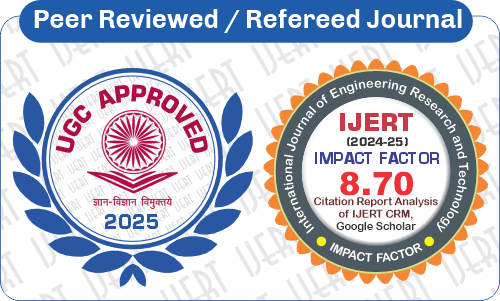 DOI : 10.17577/IJERTV4IS020886
DOI : 10.17577/IJERTV4IS020886
- Open Access

- Total Downloads : 937
- Authors : Sumanta Rakshit, Dr. Sujit Kumar Pal
- Paper ID : IJERTV4IS020886
- Volume & Issue : Volume 04, Issue 02 (February 2015)
- DOI : http://dx.doi.org/10.17577/IJERTV4IS020886
- Published (First Online): 07-03-2015
- ISSN (Online) : 2278-0181
- Publisher Name : IJERT
- License:
 This work is licensed under a Creative Commons Attribution 4.0 International License
This work is licensed under a Creative Commons Attribution 4.0 International License
Compaction and Hydraulic Conductivity Characteristics of Bentonite Mixed with Local Soil
Sumanta Rakshit1,
1Post Graduate Student,
Civil Engg Dept. National Institute of Technology, Agartala, Tripura, India,
Dr. Sujit Kumar Pal2
2Assoc. Prof.,
Civil Engg. Dept., National Institute of Technology, Agartala, Tripura, India,
Abstract – Construction of building and other civil engineering structures on clayey soil is highly risky due to poor strength properties of the clayey soil. Clays create many problems to the geotechnical engineers primarily because of repeated change of moisture content. There may be the need for soil treatment to improve the engineering properties of soil. This paper focuses on the compaction and hydraulic conductivity characteristics of bentonite mixed with local soil in different percentages (10%, 20%, 30% and 40%). Bentonite has been collected from local market Agartala, Tripura, INDIA and soils are collected from Natunnagar, Tripura, INDIA. As par ASTM standardslaboratory tests have been conducted on grain size analysis, specific gravity, Atterbergs limits, hydraulic conductivity, standard and modified Proctor compaction for determining engineering properties. In this investigation it was observed that Bentonite is very high plastic soil with liquid limit (LL) 460% whereasNatunnagar soil (local soil) is medium plastic with liquid limit (LL) 34.60%. It was observed that as the percentage of local soil increases in bentonite the value of dry density increases as a result the OMC and hydraulic conductivity decreases. Thus the bentonite mixed with local soil may be used in different geotechnical field.
Keywords: Bentonite clay, locally available soil, physical properties, maximum dry density,optimum moisture content, hydraulic conductivity.
-
INTRODUCTION
Bentonite is a type of clay that it is composed mainly of montmorillonite. This component is a swelling clay mineral of the smectite group. Bentonite also contains non swelling minerals such as quartz, feldspars, micas and carbonate, void and sand. Clays are important to the designer and the construction engineer because their structures frequently rest upon clayey formations, excavations commonly must be made into clayey materials, vast quantities of earth materials containing clays are used in embankments and linings. Permeability is the dominant parameter in the design. Large numbers of studies were done by many researchers to find out the physical and compaction, hydraulic conductivity characteristics of soils. Christidis (1998) inspected the physical and chemical properties of different bentonite and stated that Na- activation improves green compressive strength and especially wet tensile strength and decreases permeability. Muntohar (2004) explored on swelling and compressibility
characteristics of soil bentonite mixtures. The result of this study indicated that the existence of bentonite in the soil mixtures influence the swelling behavior. Mohanty et al. (2011) investigated on the influence of fly ash on the strength and swelling characteristics of bentonite clay. It was found that liquid limit and plasticity index value is decreasing with addition of fly ash content. Nath and Dalal (2004) has weighed physical and engineering properties of different soil and reported that due to increase of liquid limit, plasticity index of soil increases. Basack (1999) worked on engineering properties of marine clays and specified that the liquid limit, plastic limit and the plasticity index were observed to be significantly high, whereas the optimum moisture content was below the plastic limit. Bera et al. (2007) estimated the physical and engineering behavior of different soils. Laskar and pal (2012) have also investigated the physical and engineering behavior of different soils and their mixture. Ring et al. (1962) assessed liquid limit, plastic limit and plasticity index of soil and they established two correlations of compaction characteristics. Pal and Ghosh (2011) recommended on compaction and hydraulic conductivity characteristics of Indian fly ashes. Lundgren (1981), Kenny et al. (1992) and Abeele (1986) studied soil-bentonite mixes for liner. This study will lead us to know the influence of local soil on compaction and hydraulic conductivity characteristics of bentonite for its possible use in Geotechnical field.
-
MATERIALS AND EXPERIMENTAL PROGRAMME
-
Materials
The Bentonite used in this study is processed in powdered form and Bentonite has been collected from local market Agartala, Tripura, INDIA. Bentonite is grey in colour. Chemical compositions of Bentonite have been shown in Table 1.
Table1. Chemical composition of Bentonite(Amadi and Eberemu, 2013)
Sl no.
Chemical Composition
Values (%)
1
SiO2
58.14
2
Al2O3
21.73
3
Fe2O3
2.46
4
TiO2
1.86
5
CaO
0.86
6
MgO
2.42
7
P2 O5
0.119
8
Cr2 O3
0.007
9
K2O
0.52
10
Na2O
2.08
11
MnO
0.07
Locally available soils used in this study are natural reddish silty-clay soil collected from Natunnagar, Tripura, INDIA. The materials used are entitled as follows:
BC: Bentonite Clay, NG: Natunnagar Soil.
-
Experimental Programme
To determine the physical and engineering properties of the soils following laboratory tests have been conducted as par ASTM standards-grain size analysis, specific gravity, Atterbergs limits, standard and modified Proctor compaction, hydraulic conductivity. Grain size distribution curve of Bentonite and Natunnagar soil are presented in Fig.1 to Fig.2
Table-3: The Engineering properties of soils
SOIL NAME
BC
NG
Engineering Properties
Results
Results
Standard proctor test
*OMC (%)
31
18.5
*MDD (kN/M3)
12.05
16.75
Modified Proctor Test
*OMC (%)
19.5
12.8
*MDD (kN/M3)
15.25
18.70
Coefficient of Permeability(cm/sec)
10.84 ×10-9
7.43 × 10-6
S.N.
Symbol
BC (%)
NG
Soil (%)
* MDD
(kN/m3)
*OMC (%)
1
K1
100
0
12.34
33.5
2
K2
90
10
12.76
32.4
3
K3
80
20
13.32
29.0
4
K4
70
30
14.08
23.
5
K5
60
40
14.48
21.0
Table-4: Compaction characteristics of BC and NG soil mixtures
-
Results
-
-
-
RESULTS AND DISCUSSIONS
*OMC: Optimum Moisture Content
*MDD: Maximum dry density
This section represents the results of physical and engineering properties of bentonite and locally available soil based on the laboratory tests.Bentonite mixed with Natunnagar soil at different percentage is also investigated. Physical and engineering characteristic of bentonite, Local soil alone and bentonite mix with Local soil are presented in Table 2 to Table 5
Table-2: The physical properties of soils
SOIL NAME
BC
NG
Physical Properties
Results
Results
Specific Gravity (G)
2.75
2.49
Sand, 4.75mm-0.075mm (%)
2.5
28
Silt,
0.075mm-0.002 mm (%)
12.83
35.75
Clay, 0.002mm (%)
84.67
36.25
Liquid Limit, LL (%)
460
34.60
Plastic Limit, PL (%)
43.62
23.01
Plasticity Index, PI (%)
416.38
11.59
Table-5: Hydraulic Conductivity of Bentonite and Natunnagar soil mixtures
S.N.
Sample
Permeability by falling head test(cm/sec)
1
K1
10.84 × 10-9
2
K2
8.89 × 10-9
3
K3
7.08 × 10-9
4
K4
4.54× 10-9
5
K5
1.12 × 10-9
-
Discussions
Based on above results, discussions have been made in this section. The study of characterization soils and bentonite, Compaction characteristics of bentonite and bentonite mixed with Natunnagar soil and effect of Natunnagar soil on hydraulic conductivity of bentonite has been discussed in this section.
-
Effect on compaction characteristics
Maximum dry density (MDD) and Optimum moisture content of Bentonite, local soil has been shown in Fig.3 to Fig.4 and Table 3. It has been observed that addition of Natunnagar soil with bentonite resulted in increased maximum dry density but the optimum water content decreased. Similar trend for bentonite was observed by Wayal et al. (2012).The variation of maximum dry density and optimum water content of Bentonite mixed with local soil at different percentage is illustrated in Fig.5 and Table 4.
-
Effect of Natunnagar soil on hydraulic conductivity
-
(k) of bentonite
0.075
0.15
0.3
0.6
1.18
2.36
4.75
Hydraulic conductivity test has been conduct on Bentonite mixed with Natunnagar soil and Bentonite alone. Test result shown that hydraulic conductivity decreases with addition of Natunnagar Soil in Bentonite. The value changes from 10.84 × 10-9to 1.12 × 10-9 cm/sec. similar type of observation has been observed by Osinubi and Nwaiwu (2005) for laterite soil. The result is shown in Table 5 and Fig.6. Amadi and Eberemu (2013) also observed the same trend in their studies.
0.001
0.003
0.020
100
90
Percentage passing
80
70
60
50
40
30
20
10
0
0.001 0.01 0.1 1 10
Particle size (mm)
Fig.1 Percentage finer vs. particle size for Bentonite clay
075
0.15
0.3
425
2
4.75
20
80
0.
0.
100
Percentage passing
90
80
70
60
50
40
30
20
10
0
0.001 0.01 0.1 1 10
Particle size (mm)
10.00
-10.00
10.00
30.00
50.00
water content
STANDARD PROCTOR OF NG SOIL
5.00
MODIFIED PROCTOR OF NG SOIL
19.00
18.50
18.00
17.50
17.00
16.50
16.00
15.50
15.00
14.00
STANDARD COMPACTION
13.00 OF BC
12.00
11.00
MODIFIED COMPACTION OF BC
16.00
15.00
Dry density (kN/m3)
Dry density(kn/m3)
Fig.3 Dry density vs. moisture content curve for Bentonite clay
25.00
15.00
Water Content(%)
Fig.4 Dry density vs. moisture content curve for Natunnagar Soil
Fig.2 Percentage finer vs. particle size for Natunnagar soil sample
15
14.5
14
13.5
13
12.5
12
11.5
11
10.5
10
80% B.C+
20% NG Soil
100% B.C +
0% NG Soil
90% B.C+10%
NG Soil
70% B.C +
30% NG Soil
60% B.C
+40% NG Soil
10
30
Water Content(%)
50
18
16
14
12
10
8
6
4
2
0
Hydraulic Conductivity × 10-9 (cm/sec)
Dry density(kN/m3)
Fig.5 Dry density vs. moisture content curve for Bentonite mixed with different percentage of Natun nagar soil.
-
Specific gravity of Bentonite is higher than localsoils. Specific gravity of Bentonite is 2.75 due to highest percentage of clay.
-
The plasticity index of bentonite is 416.38% and found to be highly plastic whereas plasticity index of Local soil is 11.59 and found to be medium plastic.
-
With the increase in the clay content(36.25% for local soil and 84.67% for Bentonite),Plasticity of the soil increases.
-
MDD increases (12.34 kN/m3-14.48 kN/m 3) and OMCdecreases (33.5%-21.0%)when different percentage of Local soil mixed with Bentonite clay.
-
Hydraulic conductivity decreases with increase of flow period and maximum dry density of Bentonite mixed with local soil.
-
With addition of Local soil to Bentonite clay, hydraulic conductivity of the mix is less compared to Bentonite clay.
ACKNOWLEDGMENT
It has been a great opportunity and honour to work under the guidance of Dr. Sujit Kumar Pal. I am deeply indebted to him for providing me with the unique opportunity to work in the research area of geotechnical ground and also for enlightening me in his unique way of approaching the research problem. His valuable guidance, unlimited enthusiasm and optimistic attitude have always been a source of inspiration to me. I want to express my gratitude to him for his constant support, trust, advice, and patience he has shown.
0 1 2 3 4 5 6 7 8
Flow Period (Days)
100% BC +
0% NG
90% BC +
10% NG
80% BC
+20% NG
60% BC +
40% NG
70% BC
+30% NG
Fig.6Hydraulic conductivity vs. Flow period diagram for Bentonite mixed with different percentage of Natunnagar soil
-
-
CONCLUSIONS
This research work has been conducted to study the characterisation of the bentonite mixed with other soil so that it may be used in different geo-technical fields. From the test results following are the major conclusions drawn from the present investigations.
REFERENCES
-
Nath, A. and Dalal, S.S. (2004) The role of plasticity index in predicting compression behavior of clays, Electronic Journal of Geotechnical Engineering, vol. 9, 2004-Bundle E.
-
Laskar, A. and Pal, S.K. (2012) Geotechnical Characteristics of Two Different Soils and their Mixture and Relationships between Parameters, EJGE, 17, 2821-2832.
-
Sen, B. and Pal, S.K. (2014) Index Properties of soils collected from different locations and correlations of parameters, EJGE, 19, 3443-3452.
-
Ring, G.W., Sallberg, J. R. and Collins, W. H. (1962) Correlation of compaction andclassification test data, HRB 325, 577587.
-
Bera, A. K., Ghosh, A., and Ghosh, A. (2007) Compaction characteristics of pond ash, J. Mat. Civil Engg, ASCE, 19(4), 349357.
-
Terzaghi, K. and Peck R.B. (1967) Soil mechanics in engineering practice, 2nd edn. Wiley, New York
-
Chapuis, R.P. (1981) Permeability testing of soil-bentonite mixtures, Proceedings, 10th International conference on Soil Mechanics and Foundation engineering, Stockholm, Vol.4, 744-745.
-
Amadi, A.A. and Eberemu, A.O. (2013) characterization of geotechnical properties of lateritic soil-bentonite mixtures relevant to their use as barrier in engineered waste landfills, NIJOTECH, Vol.32, No.1, pp 93-100.
-
Bose, B. (2012) Geo-engineering properties of expansive soil stabilized with fly ash, EJGE, 17, 1339-1353.
-
Basack, S. and Purkayastha, R.D. (2009) Engineering properties of marine clays from the eastern coast of India, Journal of Engineering and Technology Research, Vol.1 (6), pp 109-114.
-
Thiyyakkandi, S. and Annex, S. (2011) Effect of organic content on geotechnical properties of kuttanad Clay, EJGE, 16, 1653-1663.
BIOGRAPHIES
Sumanta Rakshit presently is a post graduate student in Civil Engineering Dept., NIT, Agartala, Tripura, INDIA. Completed B.Tech (Civil Engineering) from Haldia Institute of Technology in 2012.
Dr. Sujit Kumar Pal is presently working as Associate Professor in Civil Engg., NIT, Agartala, Tripura, INDIA. Completed BE (Civil Engg.) from REC, Surathkal, Karnataka, INDIA (Presently, NIT, Surathkal) in 1986 and M. Tech (Soil Mech.
&Foundation Engg.) from IIT, Khragpur, West Bengal, INDIA in January, 1994. He has completed his Ph.D (Engg.) from Bengal Engineering and Science University, Shibpur, West Bengal, INDIA (Presently, Indian Institute of Engineering Science and Technology, Shibpur) in January, 2010. He has a wide range of publications in national and international Journals and conferences like, ASCE, SPRINGER,EJGE, IGC etc. His present research areas are soil characterization, soil dynamics, ground improvement, shallow and deep foundations and soil- structure interaction.





